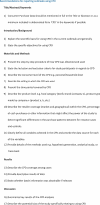A common framework for using and reporting consumer purchase data (CPD) in foodborne outbreak investigations in Europe
- PMID: 34880966
- PMCID: PMC8648039
- DOI: 10.1080/20008686.2021.2007828
A common framework for using and reporting consumer purchase data (CPD) in foodborne outbreak investigations in Europe
Abstract
Consumer purchase data (CPD) can be a powerful tool in the investigation of foodborne outbreaks through analyses of electronic records of food that individuals buy. The objective of this study was to develop a common framework for use of CPD in foodborne outbreak investigations using the expertise of European public health professionals from 11 European countries. We also aimed to describe barriers and limitations preventing CPD utilization. CPD are mainly gathered from supermarket loyalty programmes, smaller consortia, and independent supermarkets. Privacy legislation governing CPD was perceived as the most crucial barrier for CPD usage, but still resolvable. The main practical challenges were obtaining consumer consent for CPD usage, the associated workload, data access, format, and analysis. Harmonising methods and reporting across countries, standardised consent forms and electronic consent methods were identified as solutions. This guideline was developed to support outbreak investigators in overcoming barriers in using CPD, thereby increasing public health professionals' application and value of this powerful investigation tool. In addition, we hope this framework will lead to more public health institutions, in collaboration with food safety authorities, making use of CPD in outbreak investigations in the future.
Keywords: Consumer purchase data; epidemiology; foodborne outbreaks.
© 2021 The Author(s). Published by Informa UK Limited, trading as Taylor & Francis Group.
Conflict of interest statement
No potential conflict of interest was reported by the author(s).
Figures
Similar articles
-
Simulation and identification of foodborne outbreaks in a large supermarket consumer purchase dataset.Sci Rep. 2022 Jul 7;12(1):11491. doi: 10.1038/s41598-022-15584-x. Sci Rep. 2022. PMID: 35798785 Free PMC article.
-
Analysis of consumer food purchase data used for outbreak investigations, a review.Euro Surveill. 2018 Jun;23(24):1700503. doi: 10.2807/1560-7917.ES.2018.23.24.1700503. Euro Surveill. 2018. PMID: 29921346 Free PMC article. Review.
-
Investigations of Possible Multistate Outbreaks of Salmonella, Shiga Toxin-Producing Escherichia coli, and Listeria monocytogenes Infections - United States, 2016.MMWR Surveill Summ. 2020 Nov 13;69(6):1-14. doi: 10.15585/mmwr.ss6906a1. MMWR Surveill Summ. 2020. PMID: 33180756 Free PMC article.
-
Foodborne Illness Outbreak Investigation Training Needs: A Survey Among State Public Health Staff in the Northeast and Mid-Atlantic United States.J Public Health Manag Pract. 2018 Jan/Feb;24(1):34-40. doi: 10.1097/PHH.0000000000000539. J Public Health Manag Pract. 2018. PMID: 28257403
-
Epidemiology of foodborne diseases: a worldwide review.World Health Stat Q. 1997;50(1-2):30-50. World Health Stat Q. 1997. PMID: 9282385 Review.
Cited by
-
Everything but the kitchen sink: The use of multiple hypothesis generation methods to investigate an outbreak of Salmonella Enteritidis associated with frozen profiteroles and eclairs.Epidemiol Infect. 2024 Sep 30;152:e107. doi: 10.1017/S0950268824001067. Epidemiol Infect. 2024. PMID: 39344906 Free PMC article.
-
Simulation and identification of foodborne outbreaks in a large supermarket consumer purchase dataset.Sci Rep. 2022 Jul 7;12(1):11491. doi: 10.1038/s41598-022-15584-x. Sci Rep. 2022. PMID: 35798785 Free PMC article.
-
Assessment of Food and Waterborne Viral Outbreaks by Using Field Epidemiologic, Modern Laboratory and Statistical Methods-Lessons Learnt from Seven Major Norovirus Outbreaks in Finland.Pathogens. 2021 Dec 14;10(12):1624. doi: 10.3390/pathogens10121624. Pathogens. 2021. PMID: 34959579 Free PMC article.
References
-
- Havelaar AH, Kirk MD, Torgerson PR, et al., World health organization foodborne disease burden epidemiology reference group; 2015.
-
- Ethelberg S, Smith B, and Torpdahl M, et al. Outbreak of non-O157 shiga toxin–producing Escherichia coli infection from consumption of beef sausage. Clin Infect Dis. 2009;48(8):e78–7. - PubMed
-
- Taylor J, Galanis E, Wilcott L, et al., Salmonella Chester Outbreak Investigation Team . An outbreak of salmonella chester infection in Canada: rare serotype, uncommon exposure, and unusual population demographic facilitate rapid identification of food vehicle. J Food Prot. 2012;75:738–742. - PubMed
LinkOut - more resources
Full Text Sources


